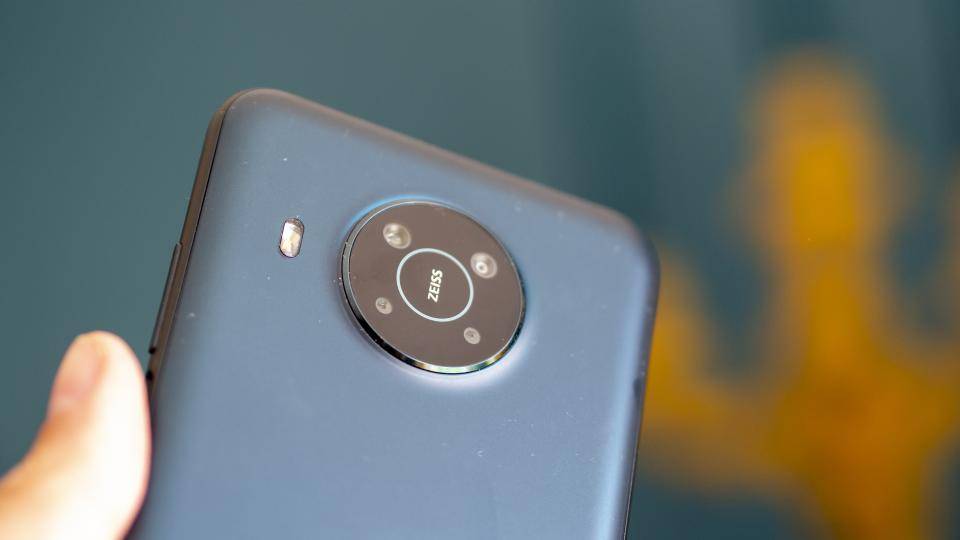Buying a good mid-range smartphone in 2021 is arguably easier than ever before. At all budget levels, thanks to stiff competition from the likes of Xiaomi and Realme, a host of good options exist for anyone looking for a new phone on the cheap.
Of course, this means that pressure on manufacturers releasing new handsets is significant, with many trying new gimmicky features to stand apart from the crowd. Amidst this, Nokia has released a slew of new phones this year, including the low-price X10. Beyond providing terrific value, it also has one core gimmick – it is supposedly more environmentally friendly.
The Nokia X10 achieves this through a bundled compostable case and removing the charger, but is a sustainability focus enough to help it rise above the rest?


Nokia X10 review: What you need to know
The main takeaway for the Nokia X10 is the use of a relatively low-end chipset in its design. Though the Snapdragon 480 is a relatively modern chipset, offering eight cores and 5G connectivity, it is still primarily intended for handsets at a lower price than the X10. Paired with 6GB of RAM it should be enough for basic smartphone operations, but may well stumble with more power-hungry applications.
At 1080p, the screen resolution is standard for the price point but lacks a high-refresh-rate or AMOLED panel, which is increasingly being adopted by the competition. An 8MP single camera on the front takes care of selfies, while the rear features a quad-cam setup with one 48MP standard sensor, a 5MP ultrawide sensor and the obligatory 2MP macro and depth sensors. These sensors are almost all that separates the X10 from its bigger brother, the X20, which features a 32MP selfie camera and a 64MP rear snapper.
READ NEXT: Our pick of the best Android smartphones
Nokia X10 review: Price and competition
Priced at £250, the Nokia X10 exists within exceptional competition, some of which offer far more in terms of features and performance.
The best among these is the Xiaomi Redmi Note 10 Pro , which comes packing a 120Hz AMOLED screen, a 108MP camera and a large 5,020mAh battery. It also uses a more powerful Snapdragon 732G chipset – all for just £229 .

There’s also the Realme 7 , which offers a 90Hz screen, 30W fast charging, a 108MP camera with 3x zoom and a more powerful Snapdragon 720G chipset for well under £200 . Nokia’s own X20 gets in the way, too, with better cameras for only £50 more than the X10.
Lastly, there’s the promising Poco X3 NFC which offers a 120Hz screen and powerful Snapdragon 732 processor, all at an entry point of £189 . Those looking for a good budget handset are spoiled for choice and the X10 clearly has its work cut out.
Nokia X10 review: Design and key features
Nokia, in its heyday, was known as something of a design powerhouse. Handsets like the Lumia 920 and 925 were admired not only for their good looks, but for their durability, too. These were phones that could take a few knocks and still flaunt it on the catwalk.
The X10 does a good job of replicating this design legacy, striving to be both durable and eye-catching, but it’s unfortunate that it only manages one of these two things. It feels sturdy and well-built, but it’s hardly the best-looking handset I’ve come across.
What can be seen across the rest of the handset is peak 2021, which is to say a slab of a smartphone with a teardrop notch, a large camera ‘oreo’ on the rear that houses the four main sensors and a tall screen with narrow bezels at the top and bottom.
READ NEXT: The best power banks to buy
On the right edge of the phone, you’ll find a volume rocker next to the power button/fingerprint sensor, while the left houses a ‘Google Assistant’ button. Unfortunately, this can’t be mapped to something more useful, and can only be deactivated, which seems like something of an oversight.
A particular feature that betrays Nokia's budget background is the choice of build material. The smooth plastic chassis doesn’t feel quite as nice in the hand as metal or glass, although it does avoid the slipperiness of either of those and allows the X10 to feel quite robust in the hand. This is a phone that feels as though it can withstand the various pressures of life, contrary to some of the competition.
Weighing 210g and measuring 9.1mm thick, there is no mistaking the fact that this is a chunky handset. Those with smaller hands may find using the X10 difficult, and for the rest, one-handed use is almost completely out of the question.
Lastly, a USB-C port is used for charging purposes, and this sits on the bottom of the X10 between a 3.5mm audio jack and speaker grille.
Nokia X10 review: Display
The screen on the Nokia X10 may be big in size, but it’s certainly not in ambition. While the competition are adopting high-refresh panels, with boosted resolutions and AMOLED tech as standard, the 6.67in offering on the X10 remains average in almost every regard. From the 1080p resolution to the bog-standard 60Hz refresh, there’s not much on offer here to outdo the competition.
This isn’t to say that the screen on the X10 is bad in any particular way. Covering 87% of the sRGB colour gamut with a total volume of 104%, the Nokia X10’s colours aren’t completely off-kilter, and the settings menu offers finer-grained controls over colour temperature as well. Most will want to skew this a little warmer than the default, which tends to be a little too cool.
A maximum brightness measured at 528cd/m2 is also pretty good, although when tested under bright sunlight it was a bit hard to use. The phone’s contrast of 1255:1 is also reasonable, with surprisingly inky-looking black levels for a mid-range LCD panel.
READ NEXT: The best budget smartphones to buy
Nokia X10 review: Performance and battery life
Where the Nokia X10 is a relatively bog-standard mid-range Android smartphone elsewhere, it does stand out with its chipset but not for entirely positive reasons. Where most smartphones these days offer as much power as possible for the price, the X10 uses a budget processor, the Qualcomm Snapdragon 480, which we last saw inside the £200 Moto G50.
With finely tuned software and plenty of RAM, this might not have proved to be an issue. It doesn’t take much to provide a smooth experience with Android these days, and the 6GB of included RAM is certainly enough from a solely specs perspective.
It’s a shame, then, that the choice of processor hinders nearly all interactions with the phone. From opening apps and playing games, to even simply swiping through the interface, there is a degree of hesitancy and lag which at best is inconvenient and at worst is quite distracting. While its rivals are doing their best to show off best times and benchmark results, the X10 is often found trying to catch its breath.
The Nokia X10 is a part of the Android One programme, which means a minimum of customisation from the manufacturer. This is as close to a ‘pure’ version of Android as possible and although it lacks personality in use, it is mostly quick, clutter-free and generally intuitive to use. The gesture-based navigation controls can prove to be finicky, however.
With regards to battery life, the X10 is something of a mixed bag. The 4,500mAh unit is certainly big enough in theory to keep the handset going throughout the day, and this is mostly borne out in testing. Running a locally stored looped video at 170cd/m² brightness while on airplane mode, the phone managed to last just over 18 hours before giving up entirely.
This is less than some of the competition managed to achieve, especially the likes of the Moto G9 Power, but it’s a respectable score nonetheless. Subjectively, the phone was always able to make it through a full day of pulling notifications and general use, though never quite making it into a second.
READ NEXT: Our pick of the best phone cameras around
Nokia X10 review: Cameras
The Nokia X10 comes with a standard camera setup, which consists of a quad array of sensors, but only two of which are useful. There is a 48MP (f/1.8) main shooter, which is flanked by a 5MP ultrawide sensor, followed by a 2MP macro camera and 2MP depth sensor.
Fittingly, images produced by the phone are mostly bang average. To begin, colours are quite pleasant across the board and although there is a tendency in general to overcook greens and reds, the warm tendency of the images worked particularly well in the hot summer sun.
The Nokia prefers a particular look in its processing, choosing always to produce a darker more contrast-y image than much of the competition. This is the spiritual opposite of the likes of the iPhone with its mostly flatter look.
A recurring issue in almost every image was detail, however, since the Nokia X10 likes to over-sharpen an image. Sharpening halos are a common facet, and while this wasn’t so much an issue in architectural shots, with foliage it tended to destroy fine detail, leaving behind a bit of a mush.
Portrait mode proved to be a pleasant surprise, with edge detection working quite well, and the included macro cam proved to capture the occasional decent image – though this took a lot of effort to achieve. Low-light performance was competent, too, but it won’t challenge the more premium competition any time soon.
The Nokia X10 captures video at either 30fps or 60fps at 1080p, with no option for 4K capture at any frame rate. Though the in-built stabilisation wasn’t up to much, the footage produced proved to be quite decent, with good colour and adequate detail. For those looking to dive deeper, a ‘Cinema’ mode is also included, allowing for a host of manual controls.
Nokia X10 review: Verdict
Producing a mid-range phone in 2021 that is not only technically good but that stands apart from the crowd is no mean feat. And despite Nokia’s best efforts with the X10, it doesn’t do quite enough to distance itself from the competition.
The focus on sustainability is certainly to be commended, however. In an era when corporate social responsibility is still the exception rather than the norm, it allows Nokia a veneer of respectability it might not otherwise have had. But the phone itself has too many compromises to be an obvious recommendation.
With a screen, battery and camera that are good enough it certainly isn’t bad, but the lack of a powerful chipset is an issue which will only become bigger with time, especially as other phones in this price bracket continue to improve.
|
Nokia X10 specifications |
|
Processor |
Octa-core Qualcomm Snapdragon 480 (2x2GHz, 6x1.8GHz) |
|
RAM |
6GB |
|
Screen size |
6.67in |
|
Screen resolution |
2,400 x 1,080 |
|
Pixel density |
395ppi |
|
Screen type |
IPS |
|
Screen refresh rate |
60Hz |
|
Front camera |
8MP |
|
Rear camera |
48MP, 5MP wide, 2MP macro, 2MP depth |
|
Flash |
LED |
|
Dust and water resistance |
No |
|
3.5mm headphone jack |
Yes |
|
Wireless charging |
No |
|
USB connection type |
USB-C |
|
Storage options |
64GB; 128GB |
|
Memory card slot (supplied) |
microSD |
|
Wi-Fi |
802.11ac |
|
Bluetooth |
5 |
|
NFC |
Yes |
|
Cellular data |
5G, 4G |
|
Dual SIM |
Yes (shared with microSD) |
|
Dimensions (WDH) |
169 x 80 x 9.1mm |
|
Weight |
210g |
|
Operating system |
Android 11 |
|
Battery size |
4,470mAh |
